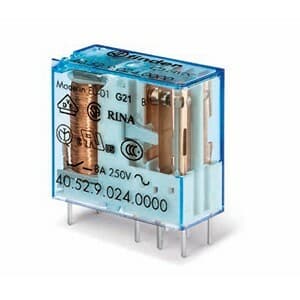Control Circuits on Powermatic Associates

Control Circuits
A control circuit is an essential part of electrical systems that allows for the control and management of various electrical devices. It acts as a relay point between a power source and devices, receiving input from sensors and sending instructions to control the actions of connected devices.
1,527 products available

Finder 95.95.3SPA is a socket designed for DIN rail or panel mounting, featuring...
19 in stock
Quick Quote

C5-A20/110VDC Turck - C5-A20/110VDC Comat Releco by TURCK, Power Relay, 11-pin f...
Quick Quote

288-800 WAGO - Constant voltage source; Input voltage: 24 VAC; 24 VDC output vol...
Quick Quote

2042-321 WAGO - Empty component plug housing; 4-pole; transparent housing; with ...
Quick Quote

C3-R20N/024VDC Turck - C3-R20N/024VDC Comat Releco by TURCK, Remanence Relay
Quick Quote

C4-A40X/024VDC Turck - C4-A40X/024VDC Comat Releco by TURCK, Power Relay
Quick Quote

C7-A20X/120VAC Turck - C7-A20X/120VAC Comat Releco by TURCK, Miniature, Power Re...
Quick Quote

C7-A20X/110VDC Turck - C7-A20X/110VDC Comat Releco by TURCK, Miniature, Power Re...
Quick Quote

857-718 WAGO - Solid-state relay module; Nominal input voltage: 230 V AC/DC; Out...
Quick Quote

859-392 WAGO - Relay module; Nominal input voltage: 24 VDC; 1 changeover contact...
Quick Quote
| Item | Manufacturer | Price | Stock | Delivery | |
|---|---|---|---|---|---|
 | 95.95.3SPA Finder 95.95.3SPA is a socket designed for DIN rail or panel mounting, featuring... | Finder | 19 in stock | Quick Quote | |
 | C5-A20/110VDC C5-A20/110VDC Turck - C5-A20/110VDC Comat Releco by TURCK, Power Relay, 11-pin f... | Turck | $21.70 | Quick Quote | |
 | 288-800 288-800 WAGO - Constant voltage source; Input voltage: 24 VAC; 24 VDC output vol... | WAGO | $122.40 | Quick Quote | |
 | 2042-321 2042-321 WAGO - Empty component plug housing; 4-pole; transparent housing; with ... | WAGO | $5.43 | Quick Quote | |
 | C3-R20N/024VDC C3-R20N/024VDC Turck - C3-R20N/024VDC Comat Releco by TURCK, Remanence Relay | Turck | $45.80 | Quick Quote | |
 | C4-A40X/024VDC C4-A40X/024VDC Turck - C4-A40X/024VDC Comat Releco by TURCK, Power Relay | Turck | $37.70 | Quick Quote | |
 | C7-A20X/120VAC C7-A20X/120VAC Turck - C7-A20X/120VAC Comat Releco by TURCK, Miniature, Power Re... | Turck | $21.70 | Quick Quote | |
 | C7-A20X/110VDC C7-A20X/110VDC Turck - C7-A20X/110VDC Comat Releco by TURCK, Miniature, Power Re... | Turck | $24.90 | Quick Quote | |
 | 857-718 857-718 WAGO - Solid-state relay module; Nominal input voltage: 230 V AC/DC; Out... | WAGO | $58.04 | Quick Quote | |
 | 859-392 859-392 WAGO - Relay module; Nominal input voltage: 24 VDC; 1 changeover contact... | WAGO | $39.06 | Quick Quote | |


